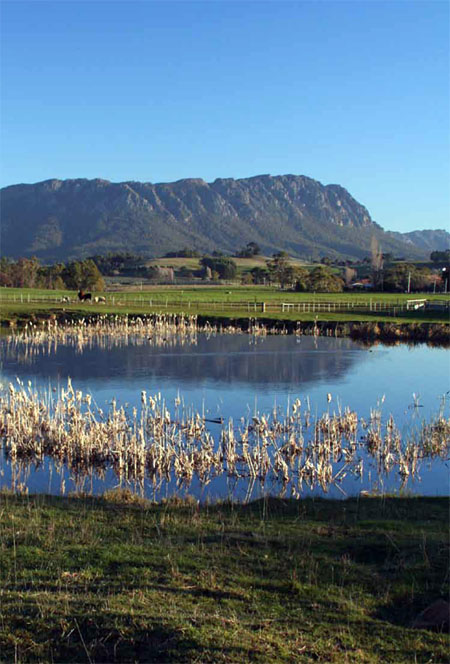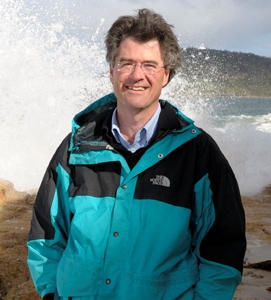Sometimes governments get it right. Climate Futures for Tasmania was an investment that is already paying off, in high-quality data about our future. [29 March 2011 | Peter Boyer]
All the angry noise about alarmism and a carbon tax doesn’t leave a lot to cheer about in the climate scene these days, so it comes as blessed relief to be able to deliver a bit of positive news.

Mount Roland towers over farm lands near Sheffield, northern Tasmania. PHOTO SUZIE GAYNOR, COURTESY ANTARCTIC CLIMATE & ECOSYSTEMS CRC
This is a real Tasmanian success story, about how government acted on a good idea (hard to believe, but true!) and funded some scientists to explore what a changing climate might do to our island home over the next century.
Drawing support from a variety of federal and state government sources and based at the Antarctic Climate and Ecosystems Cooperative Research Centre in Hobart, the Climate Futures for Tasmania group has spent the past three years investigating how science can inform our future.
In the process it brought together some bright computer modelling talents and some impressive super-computer power to draw a detailed picture of how atmospheric and marine changes over the next 90 years will affect, and be affected by, the land that is Tasmania.
The result, underpinned by some of the best scientific modelling available anywhere in the world, is a view in unprecedented detail of how this island will change over the course of the 21st century.
Specifically, the Climate Futures program aims to inform any long-term decision about how Tasmanian land is used, serving the needs of farmers and other owners or managers of land, business operators, government planners and land-use consultants, among a host of others.
The program’s 10km grid resolution provides specific local detail for strategic decisions by people “on the ground”, who in turn have been helping to guide the research from the outset.
This month, Climate Futures turned its attention to our future as a food producer and a source of hydro energy, in two reports released separately by Brian Green, Deputy Premier and Minister for Agriculture, and Nick McKim, Minister for Climate Change.
Covering climate’s changing impact on water catchments and agriculture, these reports are part of a series of five being completed over about a six-month period. The first, on general climate impacts, was released last November. Reports on extreme events and the modelling process are to come.
The reports say that Tasmania’s mid-latitude position on the globe and the strong Southern Ocean influence on its climate will limit temperature rise, giving our farmers an advantage in years to come over counterparts elsewhere in southern Australia.
Sitting on the boundary line between drying latitudes to the north and wetter regions to the south, the modelling shows our river flows and the farmlands that depend on them are relatively secure compared to many in the southern half of mainland Australia.
The moderate temperature rise and generally consistent rainfall levels are likely to bring improved growth for crops and pastures, and allow land at higher altitudes to be farmed year-round, according to the leader of the Climate Futures project, Professor Nathan Bindoff.
But the news is not universally good. While the modelling shows water flows in many agricultural catchments increasing or remaining unchanged, flows in some important hydro catchments, mainly in central, western and north-western Tasmania, are shown as reducing over the century.
The water and agriculture modelling also found:
• More areas will be able to carry more livestock carrying because warmer temperatures will allow ryegrass to be grown in more places. Simulations of wheat cropping suggests a 10-15% increase in yields, providing inputs of fertiliser and irrigation are adequate.
• Different varieties of fruits may need to be developed to respond to changing chill conditions. By the end of the century frost is projected to occur about half as often as now.
• More heat available for crops will mean changes in the choice of crop species, reduced crop duration, changes to crop yields and crop quality, and changes to incidence and severity of pests.
• Later this century Tasmanian wine producers may experience conditions similar to those in Victoria’s Rutherglen and South Australia’s Coonawarra today, increasing prospects for such warmer-climate varieties as cabernet.
• Of the 14 major irrigation storages covered by the water report, Lakes Crescent and Sorell and the Meander Dam are likely to have reduced inflows by 2100.
• Flows into Tooms Lake and Lake Leake in the Macquarie River system and Craigbourne Dam in the Coal River catchment and in the Derwent Valley and Midlands are projected to increase.
The Climate Futures reports aren’t going to bring down our carbon emissions or do anything else to reduce the impact of a changing climate; nor are they any guarantee of good times to come.
But we have reason to cheer the leading-edge ingenuity of the models and the practical information they provide for land-use planning. In these uncertain times they’re a glimmer of light in the murk. We can’t ask for more.
• Another University of Tasmania group, under Dr Michael Lockwood of the School of Geography and Environmental Studies, has just started work on a collaborative project to study Australian governments’ capacity to manage biodiversity in climate-affected marine ecosystems.
Regional climate and health scholarship to Christine Materia
An elite scholarship has been awarded to Christine Materia to fund her Ph.D in the Climate Change and Health research program at the University Department of Rural Health (UDRH) at UTAS. Christine will work with Associate Professor Erica Bell (Deputy Director UDRH) and Professor Tony Norton (Tasmanian Institute for Agricultural Research) to advance methods for the study of climate and health interactions at the regional level. Over the past twenty years Christine has worked extensively with the three spheres of government, business, industry representative bodies and community groups in Victoria, Tasmania and Western Australia in the areas of marine science, natural resource management, climate change and health. Her work has focused in translating government policy into action through protocols, partnerships, strategies and action plans. She worked with the Local Government Association of Tasmania, the Local Government Division and the Tasmanian Climate Change Office on developing the Statewide Partnership Agreement on Climate Change before developing and coordinating the Tasmanian Local Government Carbon Reduction Program. She has a strong research background in marine sciences, previously working in the area of invertebrate zoology, and has published in national and international journals. In 1996 she established the consultancy Marine and Coastal Research Tasmania, and has worked for the Institute of Fisheries Sciences (Taiwan), the National Taiwan University, Keio University of Technology (Japan) and Tokyo University. Click here to contact Christine by email; or you can reach her by phone on +61(0)362266627.

